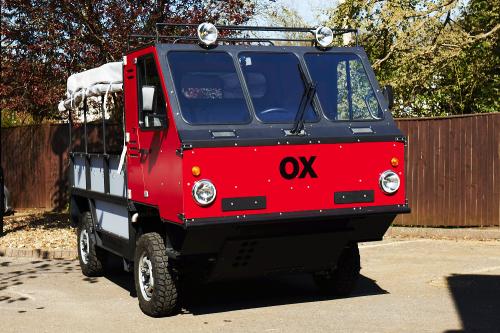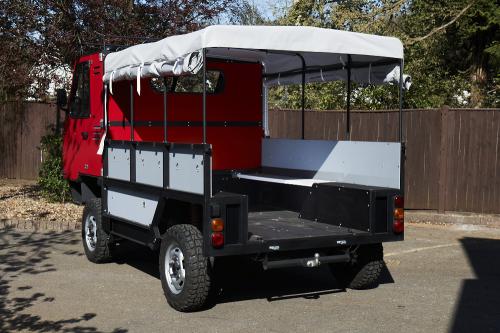The problem: Much of Africa’s rural population is poor, the roads are bad, and most western vehicles are too expensive and too fragile for prolonged use in such conditions.
The solution: British entrepreneur Sir Torquil Norman has devised the OX, an all-terrain vehicle powered by a Ford Transit engine that has a payload of two tonnes and can carry up to 13 people, eight 44 gallon drums, or three Euro pallets. It can also be shipped flat packed and assembled in 11.5 hours by three people.

The OX is the world’s first flat-pack truck and is intended to be cheap and robust enough for widespread use in rural Africa.
All-terrain, all-purpose design
OX can drive through 75 cm depth of water and has a very wide track to ensure excellent stability on badly rutted roads. Maximum payload is 2.0 tonnes (twice the capacity of most current pick-ups) and following EU size guidelines, OX can seat up to 13 people or carry eight 44 gallon drums or three Euro pallets. It has a simple power take-off capable of pumping water, sawing wood or running a generator.
Designed to be at home on the roughest terrain, the OX has a high ground clearance and short front and rear overhangs to tackle the steepest inclines. Independent suspension, front and rear, allows easy transit over rough ground, while the uncluttered underside ensures that sand, mud and other hostile surfaces do not obstruct progress.
With an overall length similar to an average family car, the OX weighs just 1.5 tonnes. It has front-wheel drive and is powered by a Ford 2.2 litre diesel engine with a manual transmission. Unladen, 73% of the OX’s weight is over the front axle and when fully loaded 53% is still over that axle. This contributes to excellent traction in both conditions.

The OX can seat 13 or carry up to two tonnes of payload.
The vehicle’s unique flat-packing qualities mean that six partially-assembled OX vehicles can be shipped in a standard 40 foot shipping container, to be assembled at their destination.
Not the first
As Sir Torquil Norman points out, the OX is not the first attempt at designing a vehicle for Africa:
“My inspiration for the OX goes back to the ‘Africar’ project of the 1980s. OX became a dream three years ago and is now a realistic ambition with a working prototype that has already completed its initial testing programme.”
The Africar project ended in financial disaster, but a more recent effort — the Mobius Car — has found some backing and is currently being developed in Kenya.
What next?
Sir Torquil has invested £1m in bringing the OX to a working prototype stage, and has established the Global Vehicle Trust with the aim of raising a further £3m, which will be required to develop the OX so that it is ready for production.
Sir Torquil says his aim is that “the OX will be purchased by charities, aid organisations and development programmes, rather than private individuals. My dream is to one day see an OX in every village in Africa.”
The OX certainly seems to have a lot of potential, and the idea that it will be purchased by aid programmes to become part of a community’s infrastructure is clever. I’m not completely sure about the durability of using a modern, fairly high-tech diesel engine, but perhaps it will be adapted to improve its robustness and reduce its reliance on regular servicing and modern oils.
My biggest question is whether the target market is big enough to achieve volume demand. Will aid agencies and western-funded development programmes engage with the idea of buying an OX to leave behind, or will they continue to provide their own western vehicles for their use, while locals continue to aspire to battered Japanese 4×4 pickups and Honda C90 mopeds?

Pingback: Flat-packed OX van is ready to roll | Van News: The VanRental.co.uk Blog